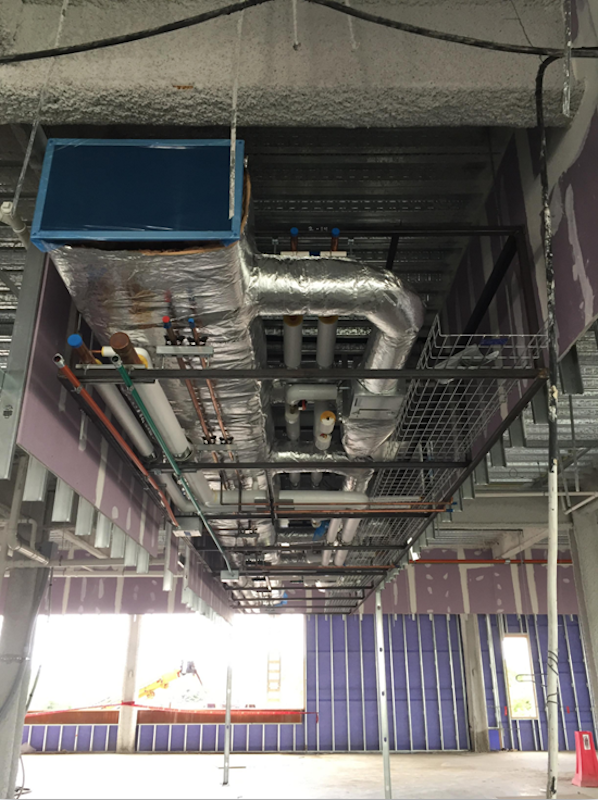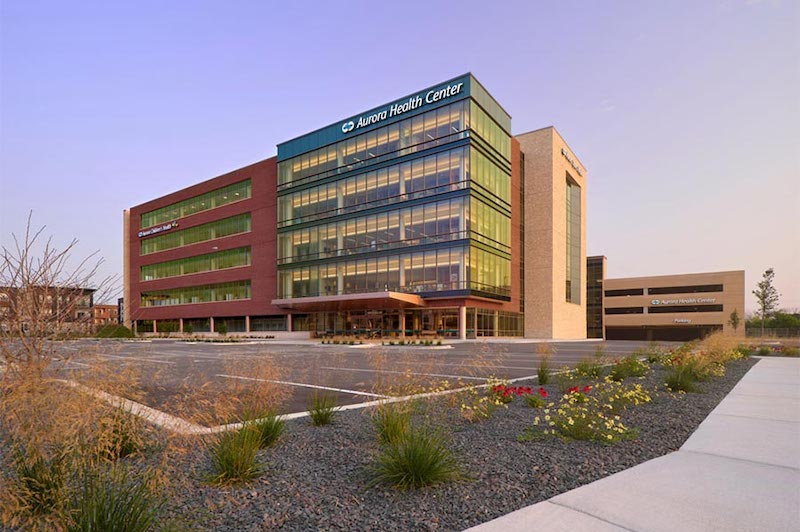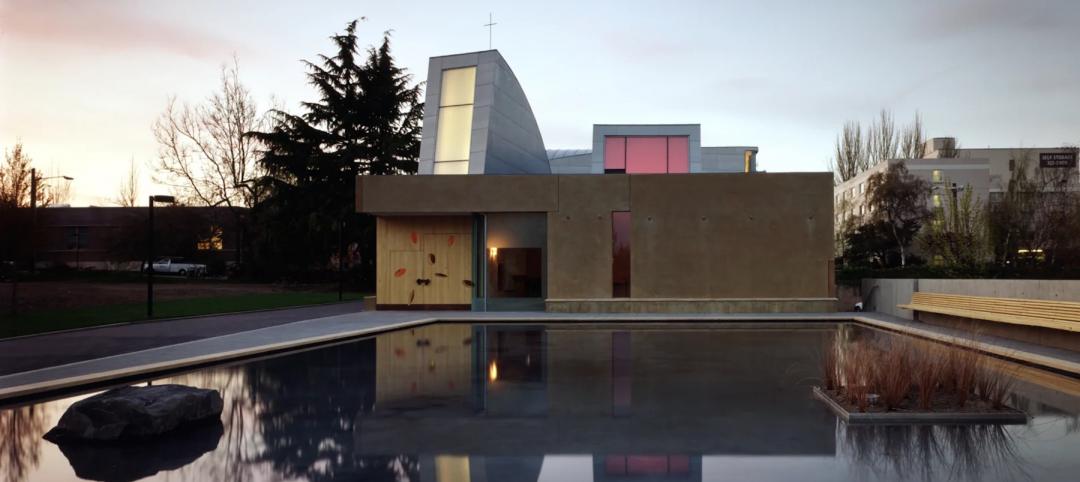Trade partners are still the odd men out during the early stages of many projects, which can make conflicts, change orders, and delays during construction more likely.
To avoid potential snafus on its new Ambulatory Health Center in Greenfield, Wis., Advocate Aurora Health and the real estate developer Cobalt Partners formed an integrated project team with the general contractor CG Schmidt, the national design firm HGA Architects and Engineers, the mechanical contractor J.F. Ahern, and the commercial electrician Staff Electric, the latter two under a Trade Management Partners (TMP) agreement.
“Advocate Aurora Health is leading the industry in integrated project delivery,” says Cory Powers, CPD, Principal and Project Manager for HGA’s energy and infrastructure group.
TMP exemplifies collaboration. Through this arrangement, skilled contractors and supplies can engage early in the project and its design process, which helps reduce redundancies, address challenges that relate to cost and constructability, and come up with more efficient solutions.
The client’s key goal for this five-story 146,200-sf project, located in the 40-acre 84South mixed-use development, was speed to market so it could start seeing patients as soon as possible. That objective led the team to focus on using Lean Construction Methods to accelerate the project’s schedule.
PUSHING THE ENVELOPE ON PREFAB

Two-fifths of the work within 80 MEP racks were prefabricated.
To this end, the project pushed the limits of prefabrication through the use of 80 multi-trade prefab MEP racks that included long sections of duct work in the corridors.
Forty percent of the above-ceiling MEP work was prefabricated off-site. The construction was completed in 18 months, which gave the community local access to healthcare one month earlier compared to a traditional delivery method. Zero percent rework was achieved versus 15% rework in traditional delivery methods. And there were no injuries building and installing the MEP racks.
The team members worked in tandem from a single 3D BIM model, eliminating miscommunication and the need for re-drawings. And to reduce the risk of design errors, the team relied on state-of-the-art fabrication software, with each component barcoded and shipped to the jobsite along with an installation plan.
Using their mobile devices, workers scanned the barcodes to verify the location for each installation. Once on site and verified, the prefabricated racks were lifted to each floor to be connected and attached, a task completed within an hour of each delivery.
Powers of HGA says that prefabrication emerged as a solution during the team’s early design discussions. And the building’s systems “were laid out to be modular.” Powers adds that prefab is playing an even more prominent role in the design and construction of Advocate Aurora Health’s next two hospitals that will include bathrooms and exam rooms assembled off site.
The completed Ambulatory Health Center, which opened August 5, is valued at $55.5 million. The building is the central location for Advocate Aurora Children’s Health services that include pediatric cardiology, urology, allergy, dermatology, ENT, neuropsychology, and radiology. It has eight surgical suites, two pain management procedure rooms, four GI suites and two outpatient interventional radiology suites that are the first of their kind in Wisconsin.
With the Health Center’s recent opening, Advocate Aurora Children’s Health can offer more comprehensive pediatric services to the area. The facility also houses Advocate Aurora’s Sports Health services, along with a pediatric sports health gym and classroom space. This space brings increased availability for outpatient orthopedic surgery to patients.
The Health Center is home to midwifery services with a variety of women’s health services provided, ranging from general health education to family planning and obstetric care. Its outpatient center co-locates orthopedic exam, office, and imaging conveniently at the retail-inspired main entry, with surgical, recovery, and pain management services on floors above.
IPD ‘THE PATH FORWARD’
“This 84South facility is actually one of the very largest outpatient ambulatory sites in all of our Wisconsin and Illinois footprint, and it will enable us to open up access for the people of the broader Greenfield community,” said Advocate Aurora Health's COO Bill Santulli, in an interview with the Milwaukee Business Journal.
When asked why integrated project delivery isn’t more common, Powers says that each AEC firm and owner is at different stages of its Lean journey. “You can’t fake experience in an IPD.” Too many firms and owners “are stuck in delivery methods that are based on fear” that they wouldn’t get the same value from an IPD contract.
“But once you go through one of these, there’s nothing else like them,” says Powers. “We can go pretty fast on our own. But it’s so much faster when you don’t have to explain everything in the field. The team comes out of the gate drumming the same beat when you’ve worked out the details months before the first dirt is broken.”
Mark Lillesand, a Vice President with CG Schmidt, thinks that integrated project design will become more prevalent as more owners become familiar with its benefits, which include “furthering our relationships with subcontractors.”
Lillesand says his firm now “prefabricates everything we can” especially now when the coronavirus has raised the stakes for jobsite safety. He adds that on other projects, CG Schmidt has included subs for drywall, steel construction, and enclosures into the early design discussions. “This is the path forward for us.”
Related Stories
Museums | Jun 28, 2022
The California Science Center breaks grounds on its Air and Space Center
The California Science Center—a hands-on science center in Los Angeles—recently broke ground on its Samuel Oschin Air and Space Center.
Contractors | Jun 27, 2022
Reverse mentorship: A model for the future of the construction workforce
Reverse mentorship can help seasoned professionals develop new skills, stay connected with younger generations, and gain future-forward insights for life and business.
Building Team | Jun 27, 2022
Chapel of St. Ignatius by Steven Holl Architects receives AIA’s twenty-five year award
The American Institute of Architects (AIA) is honoring the Chapel of St. Ignatius in Seattle, designed by Steven Holl Architects, with its Twenty-five Year Award.
Green | Jun 22, 2022
The business case for passive house multifamily
A trio of Passive House experts talk about the true costs and benefits of passive house design and construction for multifamily projects.
Building Team | Jun 22, 2022
Design for new San Clemente Marine Safety Headquarters would create new public plaza
A proposed design by HMC Architects for a new San Clemente Marine Safety Headquarters makes creative use of the seaside topography of the Pacific Coast.
Augmented Reality | Jun 22, 2022
Not just for POKÉMON GO anymore: how augmented reality is transforming architecture
By solving a long-standing communication problem, Augmented Reality (AR) is poised to make architecture quicker, nimbler, and more cost effective.
Healthcare Facilities | Jun 22, 2022
Arizona State University’s Health Futures Center: A new home for medical tech innovation
In Phoenix, the Arizona State University (ASU) has constructed its Health Futures Center—expanding the school’s impact as a research institution emphasizing medical technology acceleration and innovation, entrepreneurship, and healthcare education.
Market Data | Jun 22, 2022
Architecture Billings Index slows but remains strong
Architecture firms reported increasing demand for design services in May, according to a new report today from The American Institute of Architects (AIA).
Green | Jun 22, 2022
World’s largest commercial Living Building opens in Portland, Ore.
The world’s largest commercial Living Building recently opened in Portland, Ore.
Multifamily Housing | Jun 21, 2022
Two birds, one solution: Can we solve urban last-mile distribution and housing challenges at the same time?
When it comes to the development of both multifamily housing and last-mile distribution centers, particularly in metropolitan environments, each presents its own series of challenges and hurdles. One solution: single-use structures.

















